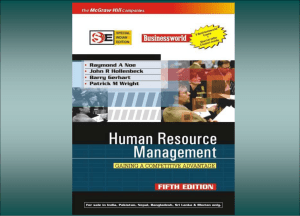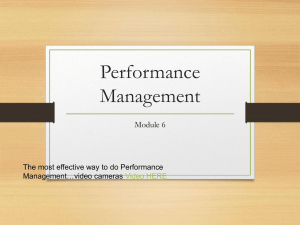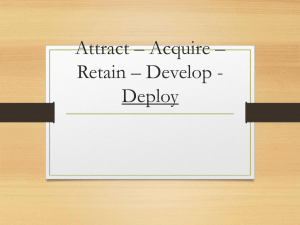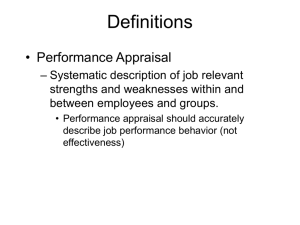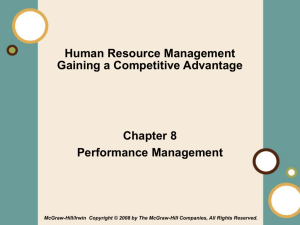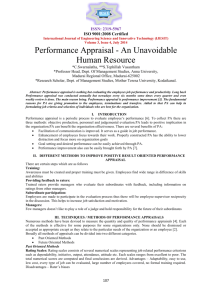Human Resource Management 12e.
advertisement
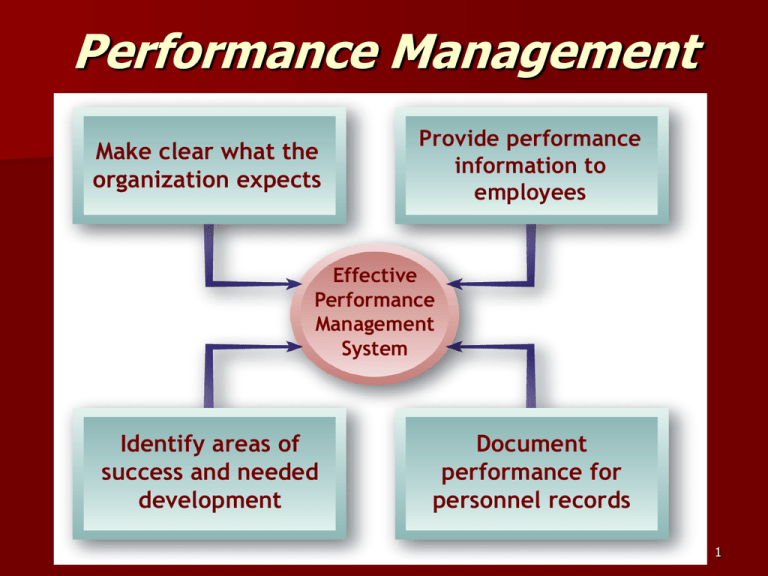
Performance Management Make clear what the organization expects Provide performance information to employees Effective Performance Management System Identify areas of success and needed development Document performance for personnel records 1 Performance Management Linkage 2 Performance Management versus Performance Appraisal Performance Management Processes used to identify, encourage, measure, evaluate, improve, and reward employee performance Performance Appraisal The process of evaluating how well employees perform their jobs and then communicating that information to the employees 3 Components of a Performance-Focused Culture 4 Identifying and Measuring Employee Performance *Quantity of output *Quality of output *Timeliness of output *Presence *Citizenship Team member 5 Identifying and Measuring Employee Performance Job Duties – Important elements in a job as identified from job descriptions. – What an employer pays an employee to do. 6 Types of Performance Information Subjective Objective 7 Relevance of Performance Criteria Factors: – Deficient measures – Contaminated measures – Overemphasized measures 8 Example: ACTFL Performance Standards for Speaking Proficiency 9 Performance Metrics in Service Businesses Common Sources of Performance Differences Regional Labor Cost Differences Service Agreement Differences Equipment/ Infrastructure Differences Work Volume Performance that is measured can be managed. 10 Conflicting Uses for Performance Appraisal 11 Decisions About the Performance Appraisal Process Appraisal responsibilities 2. Informal vs. systematic processes 3. Timing of appraisals 4. Source(s) of performance information 1. 12 Legal Concerns and Performance Appraisals Legally Defensible Performance Appraisal System: • Appraisal criteria based on job analysis (i.e., job-related) • Absence of disparate impact and evidence of validity • Formal evaluation criteria that limit managerial discretion • Formal rating instrument linked to job duties and responsibilities • Personal knowledge of and contact with ratee • Training of supervisors in conducting appraisals • Review process to prevent undue control of careers • Counseling to help poor performers improve 13 Typical Division of HR Responsibilities: Performance Appraisal 14 Performance Information Sources 1. 2. 3. 4. 5. 6. Supervisor ratings Team member/peer evaluation Subordinate evaluation Self-appraisal Customer feedback 360 Degree 15 Employee Rating of Managers Advantages Disadvantages • Helps in identifying competent managers • Serves to make managers more responsive to employees • Contributes to the career development of managers • Negative reactions by managers to ratings • Subordinates’ fear of reprisals may inhibit them from giving realistic (negative) ratings • Ratings are useful only for self-improvement purposes 16 Team/Peer Rating Advantages • Helps improve performance of lowerrated individuals Disadvantages • Can negatively affect working relationships • Peers have opportunity to observe other peers • Can create difficulties for managers in determining individual performance • Peer appraisals focus on individual contributions to teamwork and team performance • Organizational use of individual performance appraisals can hinder the development of teamwork 17 Performance Management Linkage 18 Category Scaling Methods Graphic Rating Scale – Allows the rater to indicate an employee’s performance on a continuum of job behaviors. Aspects of Performance Measured Descriptive Categories Job Duties Behavioral Dimensions 19 Sample Performance Appraisal Form 20 Graphic Rating Scales Disadvantages: • Restrictions on the range and type of rater responses • Differences in rater interpretations of scale item meanings and scale ranges • Rating form deficiencies limit effectiveness of the appraisal • Poorly designed scales that encourage rater errors 21 Sample Terms for Defining Anchors 22 More Scaling Methods Behaviorally Anchored Rating Scale (BARS) – Composed of job dimensions (specific descriptions of important job behaviors) that “anchor” performance levels on the scale. Developing a BARS – Identify important job dimensions – Write short statements of job behaviors – Assign statements (anchors) to job dimensions – Set scales for anchors 23 Behaviorally-Anchored Rating Scale Example for Customer Service Skills 24 Comparative Methods Ranking – – Listing employees from highest to lowest Disadvantages 1. Doesn’t reflect size of differences between employees 2. Implies that lowest-ranked employees are unsatisfactory performers. 3. Laborious if the group to be ranked is large. – Paired comparisons 25 More Comparative Methods Forced Distribution – Employee performance ratings distributed along bell-shaped curve. Advantages • Helps deal with “rater inflation.” • Makes managers identify high, average, and low performers. • Ensures that compensation increases reflect performance differences among individuals. Disadvantages • Managers resist placing people in the lowest or highest groups. • Explanation for placement can be difficult. • Performance may not follow normal distribution. • Managers may make false distinctions between employees. 26 Forced Distribution on a Bell-Shaped Curve 27 Narrative Methods Critical Incident – Manager keeps written record of highly favorable and unfavorable employee perf. – Disadvantages 1. Variations in how managers define “critical incident” 2. Time consuming and limited opportunity to observe 3. Most employee actions are not observed and may change if observed 28 Narrative Methods Essay – Manager writes essay describing an employee’s performance. – Disadvantages 1. Depends on the managers’ writing skills and their ability to express themselves. 2. Time consuming 3. May lack opportunities to observe perf. 29 Management by Objectives (MBO) Management by Objectives – Performance goals that an individual and his/her manager agree the employee will to try to attain within appropriate length of time. Key MBO Ideas – Employee involvement creates higher levels of commitment and performance. – Employees encouraged to work effectively toward goals. – Perf. measures should be measurable and should define results. 30 The MBO Process 1. Job review and agreement 2. Development of performance standards 3. Setting of objectives 4. Continuing performance discussions 31 MBO Process Job Review and agreement 2. Development of performance standards 3. Setting of objectives 4. Continuing performance discussions 1. 32 Preparing Managers to Deliver Performance Information 1. 2. 3. 4. 5. 6. Procedure and timing Performance criteria Rating errors Delivering feedback Compensation decisions Training needs assessment 33 Common Rater Errors 34 Hints for Delivering an Effective Performance Appraisal 35 Strategic Performance Management System *Consistent with org strategic mission *Documents performance *Perceived as fair *Legal and job-related *Developmental tool—leads to performance improvement, promotion, etc. 36
